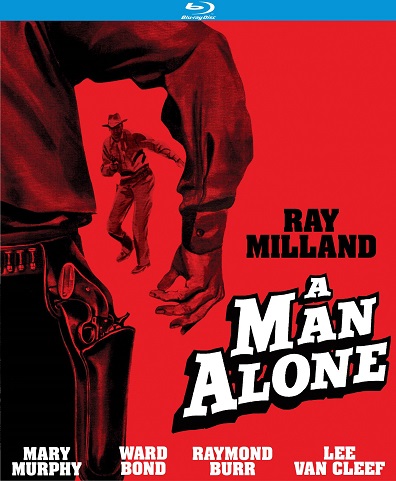
A Man Alone
Studio: Kino Lorber Studio Classics
Dec 05, 2018
Web Exclusive
![]()
During a fall awards season featuring major releases directed by Bradley Cooper, Jonah Hill, Joel Edgerton, Paul Dano and Clint Eastwood, it’s easy to imagine that actors turned directors were always an easy ticket to prestige. But during the days of the old Hollywood studio system where the assembly line approach to filmmaking didn’t allow for much lane switching, even the biggest stars had tough times climbing into the directors saddle. By 1955, actor Ray Milland had spent twenty years as a contract player for Paramount. Ten years earlier, he had become a debonair leading man, winning a Best Actor Oscar for an against-type performance as an alcoholic writer in The Lost Weekend, and starring in films for major directors like Billy Wilder, Fritz Lang, George Cukor and Alfred Hitchcock. But when he wanted to make his directorial debut, even a star of Milland’s caliber could only get it done at Republic Pictures, a third-tier studio known for cheap Westerns.
A cheap Western is exactly what A Man Alone is, although that doesn’t make it a bad one. Flatly lit, plainly staged and rendered in Trucolor - a drab looking in-house Cinecolor knockoff - it’s easy to see how the film was lost amid the classics of the genre from that decade such as High Noon, The Searchers and Rio Bravo. A Man Alone feels closer to the cycle of 1950s Westerns made by director Anthony Mann and Jimmy Stewart over at Universal, including Winchester ’73, Bend in the River and The Far Country; modest in their ambitions but lean and forceful in their storytelling. It also doesn’t hurt that both Milland and Stewart transformed into similarly weathered sad-eyed hang-dogs in their later years.
Even the Mann/Stewart Westerns put A Man Alone to shame with their breathtaking scenic vistas. Despite being shot on location in Utah, the film mostly confines itself to the interior of a single house in an Arizona desert town where Milland’s titular outlaw holes up after being falsely accused of a vicious crime. Also occupying the house are the ailing town sheriff and his beautiful daughter. But before all that, Milland does an excellent job of establishing his tone via a grim opening that finds his character - Wes Steele - putting down his injured horse and finding himself stranded in the desert, wandering silent and alone for nearly ten wordless minutes in a sequence that lives up to the film’s title. When he stumbles across the ruins of a stagecoach massacre, the camera zeros in on a child’s doll trampled in the dirt. This would have been brutal enough by classic Hollywood standards, but as Milland the actor peeks inside the stagecoach, Milland the director has the camera track up past the shoes, stockinged legs and still hands of a little girl. We never see the injury that makes Steele turn away in disgust, but that shot alone positions A Man Alone as a herald of the unflinchingly violent revisionist Westerns that would define the genre in the coming decades.
Although the film features some crackling dialogue once Steele reaches town and meets the rest of the cast, this early sequence reveals Milland’s patience as a director, and said patience goes a long way toward making the most of his presumably cheap sets and limited shooting schedule. Guided by his restraint, the sharp script - best exchange: “You can’t shoot an unarmed man.” “No, but I can sure beat you death.” - and terrific supporting cast make the familiar memorable. Future The Good, the Bad and the Ugly star Lee Van Cleef is on hand as one of the villains, and prolific character actor Ward Bond plays the sheriff, giving a speech that lays out the ethos of Western revisionism a decade before critics identified the movement: “We had high hopes and big dreams but none of them worked out…back East they all talk about how wonderful the West is…but folks who tell you that have never seen the West.”
Also of note is Mary Murphy as the sheriff’s daughter and Steele’s love interest. Few genres have been more thankless to female characters and performers than the Western, but A Man Alone gives Nadine emotional agency and plenty of screen time to voice her opinions. Murphy herself is a terrific balance between the elegant, airy beauty of 1950s leading ladies and hard-assed, lived-in texture usually reserved for male characters of the era. Like everything else in the film, Milland affords her relationship with Steele the patience and restraint necessary to feel true, even if it looks common.
www.kinolorber.com/product/a-man-alone-blu-ray
Current Issue

Issue #72
Apr 19, 2024 Issue #72 - The ‘90s Issue with The Cardigans and Thurston Moore
Most Recent
- Sam Evian on “Plunge” (Interview) — Sam Evian
- Maya Hawke Shares Lyric Video for New Song “Hang in There” (News) — Maya Hawke
- Premiere: Anna Tivel Shares New Single “Desperation” (News) — Anna Tivel
- Nilüfer Yanya is a Runaway Bride in the Video for New Song “Like I Say (I runaway)” (News) — Nilüfer Yanya
- Storefront Church Announces New Album, Shares New Song “Coal” (Plus Live Video) (News) — Storefront Church

Comments
Submit your comment
There are no comments for this entry yet.